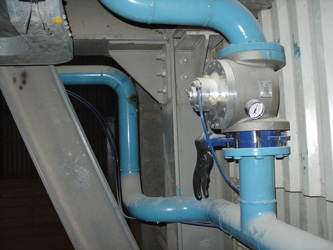 Barra Project International produces and proposes AIRFLASH® the system for silos cleaning and contamination risk reduction
Barra Project International produces and proposes AIRFLASH® the system for silos cleaning and contamination risk reduction
Silos and hoppers are typically used for the storage of different types of materials, from food to aggregates (feed, cereals, grains, industrial powders, gypsum, cement, fly ash, clinker, pharmaceutical products, wood chips, metal and plastic fibers, etc.). Cleaning the silos is essential to maximize storage efficiency and to avoid the aging of stored materials.
By silo cleaning, we mean the containment of the risk of material compaction and encrustation and the regular emptying of the silo contents: the regular flow of material from the storage facilities is essential to guarantee the continuity of the production chain and the good quality and conservation of the product.
The material is supplied from the top of the silo and extracted from its bottom according to a “first-in first-out” loading logic; this means that the “older” material must be the first to be extracted and this is essential to avoid contamination and/or deteriorations. This operating logic is feasible only if the regular product outflow and the periodic cleaning of the silo are guaranteed. This is possible by preventing phenomena of bridging (formation of bridges that block the escape of material from the silo) and of rat holing (compactions of material around the silo unloading mouth and along the walls). Rat holing in particular, in addition to reducing the storage capacity of the structures, compromises the quality of the material (in the dead zones the product stagnates and ages): the new material immediately comes into contact with the old, becoming contaminated and polluted. This irreparably compromises the quality of the entire contents of the silo. Operational management risks must also be taken into account: due to deterioration, some materials can in fact generate dangerous gases.
The cleaning system produced and proposed by Barra Project International Srl are the AIRFLASH® compressed air cannons. Extensively tested and proven efficient system, the compressed air cannon is an energy accumulator consisting of a quick exhaust valve (firing head) and a tank for storing the compressed gas. The operation of the cannon is simple, but extremely effective: the cannon generates a shock wave that is instantly released inside the clogged storage structure: the impact breaks up bridges, compactions and encrustations. The cannon also performs a preventive action on the formation of clogging and promotes the natural flow of material: the periodic injections of compressed air keep the material constantly moved.
The strength of AIRFLASH® cannons, unlike traditional vibrators, is that the cannon has a direct fluidifying action on the material; this means that AIRFLASH® avoids the fatigue stresses on the structures thus extending their useful life (vibrators, on the other hand, can cause structural damage and can contribute to the compaction of materials, especially if they are fine-grained, worsening the blocking conditions of the silo).
AIRFLASH® cannons have a modular structure that allows a high degree of customization and optimization of spare parts warehouse management. Specific silencing measures make AIRFLASH® applicable also nearby residential areas. The AIRFLASH® range includes tanks from 0,5Lt up to 150Lt with a maximum operating pressure of 10bar; application temperatures from -10°C to +100°C.
Main advantages of AIRFLASH®:
a) continuous handling of the material and cleaning action of the structures: thus, avoiding the creation of dead zones where the material is at risk of deterioration for long parking periods and avoiding sudden landslides of product piles that can damage the internal structure of the silo
b) optimization of the storage capacity of the structure
c) reduction/cancellation of production slowdowns and plant shutdowns caused by the clogging of storage facilities
d) avoids the need for cleaning and/or manual unlocking of the silo to protect the safety of area operators: the cannon has a preventive action on the formation of clogging and thus eliminates the need for risky extraordinary maintenance operations for unlocking and emptying of silos. Manual cleaning is dangerous (as well as obsolete): the personnel, lowered from above inside the structures by rope, is subjected, in the presence of rat holing, to the risk deriving from the fall of material from above and the presence of gas, while in the presence of bridging phenomena, to the risk of dragging on the bottom once the bridge is broken. In case of bridging, also the manual release of the bottom of the silo from the outside is highly risky: the operator is in fact exposed to the sudden vertical fall of the material being unloaded from the structure.






